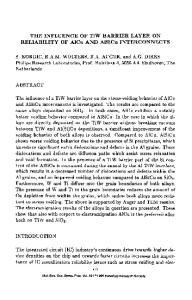Adhesion and reliability of copper interconnects with Ta and TaN barrier layers
- PDF / 318,816 Bytes
- 9 Pages / 612 x 792 pts (letter) Page_size
- 31 Downloads / 373 Views
MATERIALS RESEARCH
Welcome
Comments
Help
Adhesion and reliability of copper interconnects with Ta and TaN barrier layers Michael Lane and Reinhold H. Dauskardt Department of Materials Science and Engineering, Stanford University, Stanford, California 94305-2205
Nety Krishna and Imran Hashim Applied Materials Corporation, Santa Clara, California 95052 (Received 20 August 1999; accepted 25 October 1999)
With the advent of copper metallization in interconnect structures, new barrier layers are required to prevent copper diffusion into adjacent dielectrics and the underlying silicon. The barrier must also provide adequate adhesion to both the dielectric and copper. While Ta and TaN barrier layers have been incorporated for these purposes in copper metallization schemes, little quantitative data exist on their adhesive properties. In this study, the critical interface fracture energy and the subcritical debonding behavior of ion-metal-plasma sputtered Ta and TaN barrier layers in Cu interconnect structures were investigated. Specifically, the effects of interfacial chemistry, Cu layer thickness, and oxide type were examined. Behavior is rationalized in terms of relevant reactions at the barrier/dielectric interface and plasticity in adjacent metal layers.
I. INTRODUCTION
Current semiconductor technology dictates the use of low-resistivity metal lines for multilayer interconnect devices. Currently, Al–Cu metal layers are employed in most devices; however, copper has emerged as an attractive alternative. Copper has a higher conductivity and superior electromigration resistance than aluminum alloys leading to shorter resistance capacitance (RC) delay times and reduced failure due to electromigration.1–3 However, integration of Cu lines into interconnect structures poses several challenges. Cu is a more mobile element than Al and, for example, diffuses rapidly in SiO2 and forms silicides at temperatures as low as 200 °C.1,4,5 A reliable barrier layer is therefore needed to inhibit the diffusion of copper into adjacent dielectric layers and the silicon substrate. In addition, the barrier layer must also provide adequate adhesion to both the dielectric and metal layers. The resulting adhesive strength must be able to withstand the high residual stresses associated with thermal expansion mismatch and film growth processes, as well as the high back stresses developed during electromigration processes in the Cu lines.2,3 Tantalum and tantalum-based films have emerged as promising diffusion barriers for copper interconnects. While much effort has been made to characterize the phase stability and diffusion barrier properties of these layers (e.g., Refs. 6 and 7), almost no attention has been given J. Mater. Res., Vol. 15, No. 1, Jan 2000
http://journals.cambridge.org
Downloaded: 15 Mar 2015
to their adhesive and fracture properties. Accordingly, in this study we address the adhesion and subcritical debonding behavior of the barrier/SiO2 interface, together with its microstructural and chemical determinants. By adhesion
Data Loading...











